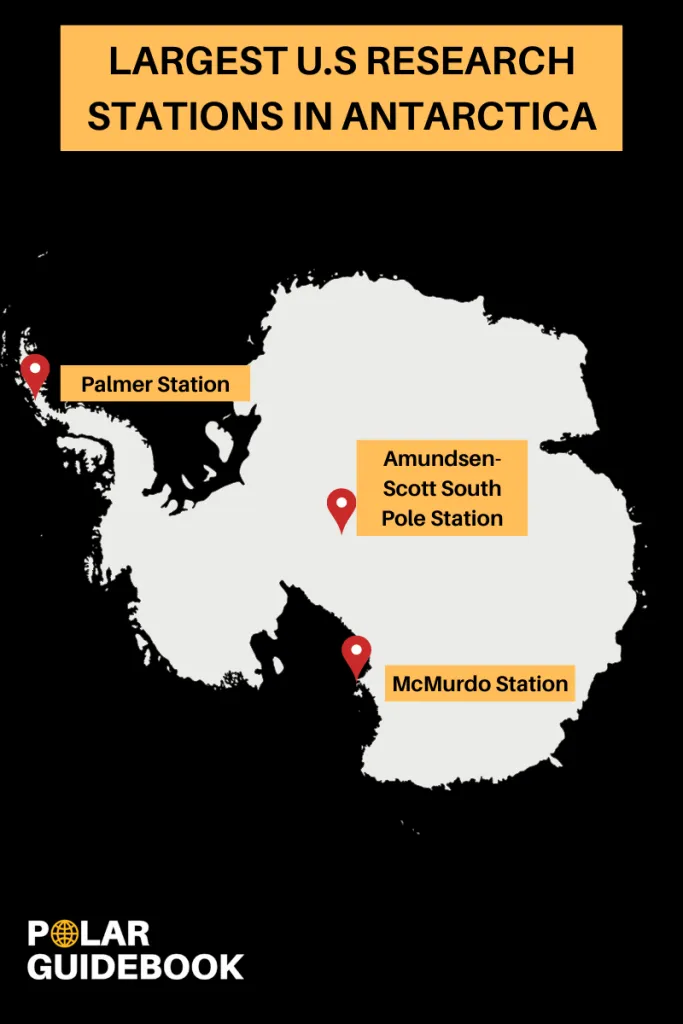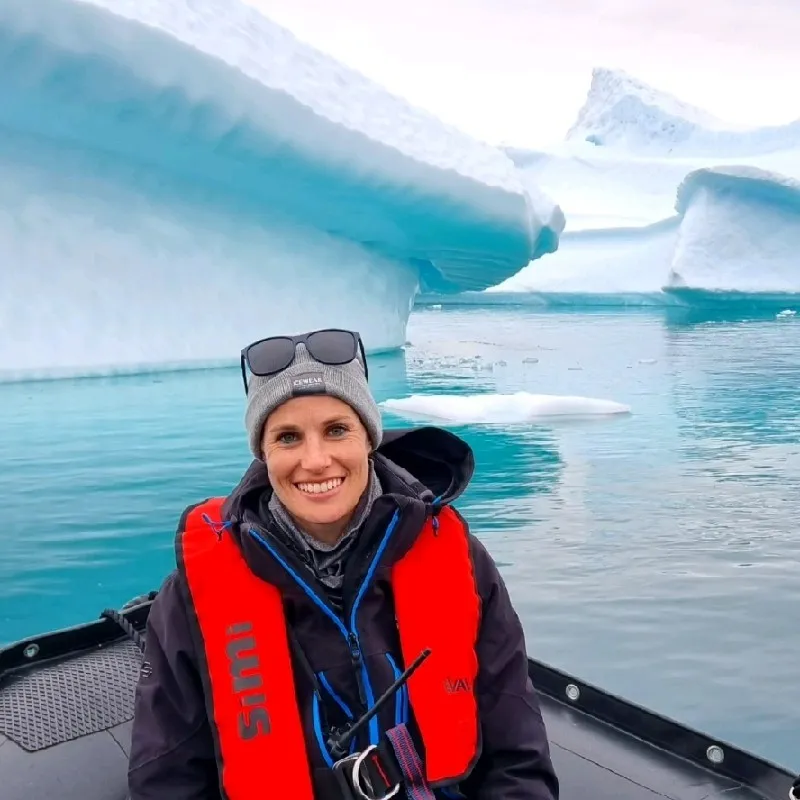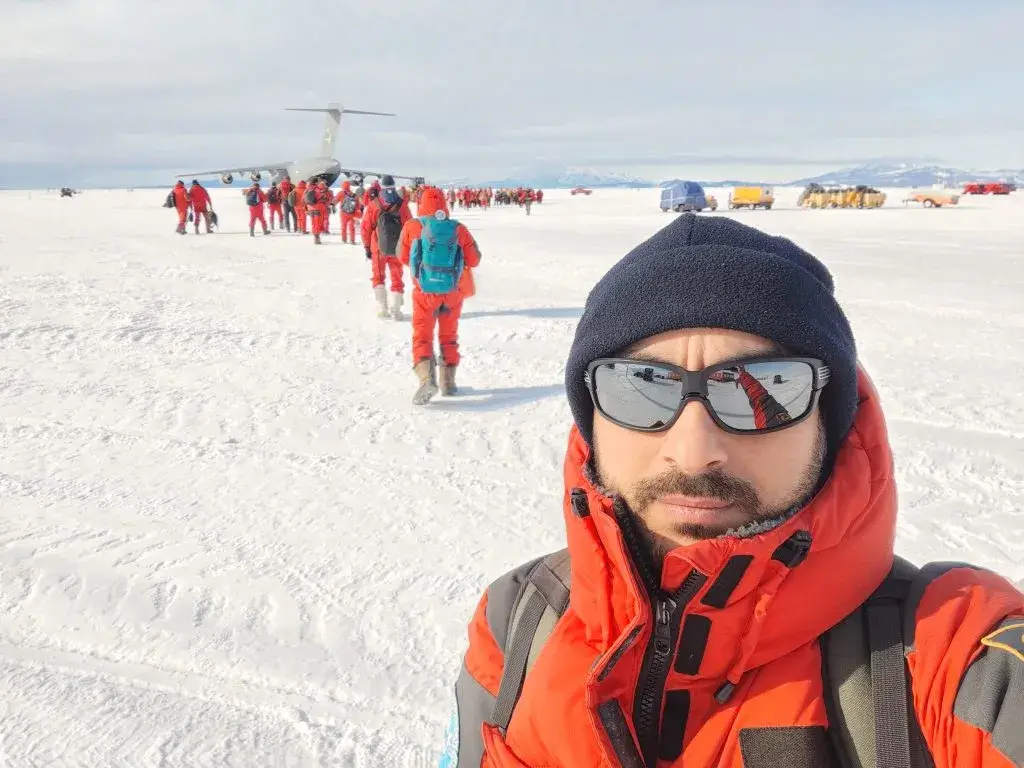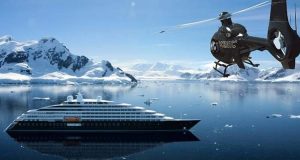In this comprehensive guide, we spoke with experts who’ve cumulatively worked for over 10 years in Antarctica to walk you through the process of securing a job there, offering invaluable insights into the intricate steps, requirements, and preparations involved.
From conducting groundbreaking research to providing essential support for scientific missions, working in Antarctica presents a one-of-a-kind opportunity that can be both professionally rewarding and personally transformative. However, with high demand and a limited supply of jobs, it is far from easy to find work in Antarctica.
So whether you’re a scientist eager to contribute to cutting-edge research, an outdoor enthusiast seeking an unparalleled adventure, or simply curious about the practicalities of working in this extreme environment, we’ve got you covered.
- What kind of jobs can you do in Antarctica?
- How do I apply for a job in Antarctica?
- How many research stations are there in Antarctica in 2023?
- Map of U.S research stations in Antarctica
- National Antarctica Programs
- Seasons in Antarctica
- Do they have hotels in Antarctica?
- Working in Antarctica: Q&A with Nikita Steele, an Antarctic Expedition Guide
- What exactly does your job as an expedition guide in Antarctica entail?
- What qualifications, skills, and experiences do expedition companies usually look for in potential guides for Antarctica?
- What advice would you give to someone who is passionate about working as an expedition guide in Antarctica but lacks prior guiding experience?
- Working in Antarctica: Q&A with Luca Ficara, Veteran Chef in Antarctica
- Related questions
What kind of jobs can you do in Antarctica?
There are numerous types of roles available in Antarctica. Typically speaking, jobs are divided into scientific positions and support positions.
Individuals interested in joining research teams or support staff in Antarctica should be prepared for rigorous screening processes, comprehensive training, and a commitment to adhere to strict environmental protocols to ensure minimal impact on this delicate ecosystem.
We breakdown some of the employment possibilities below for North American, British, and Australian residents.
Jobs in Antarctica for North Americans
According to the U.S. Antarctic Program’s (USAP) website, they deploy around 3,000 people to Antarctica every year, mainly during the austral summer from October through February.
USAP runs three U.S. scientific stations year-round in Antarctica: McMurdo Station, Palmer Station, and South Pole Station. McMurdo Station is the main U.S. station in Antarctica, operated by the United States Antarctic Program.
Roles vary: USAP hire scientists who conduct research, support staff who operate and maintain the U.S. research stations and vessels, members of the military and other federal agencies, artists and writers who use art to broaden public awareness of Antarctica, and members of the media who report on Antarctic science.
Jobs in Antarctica for Brits
The British Antarctic survey has positions open for Pilots, Mariners, station and field support (such as chefs and guides), and engineering and technology.
Jobs in Antarctica for Australians
The Australian Antarctic Program has job postings online for a diverse array of roles, like: electrician and refrigeration mechanics, refuelling supervisors, communications operators, chefs, aircraft ground support, and medical practitioners.
At the time of writing, none of these positions were open but it’s recommended to check their site regularly to catch new openings.
Can you get a job in Antarctica with zero experience?
We scoured online job listings to answer this question for you and we weren’t able to find any jobs hiring people with zero experience. The lowest required work experience we found was 6 months, for a Food Services Steward at McMurdo Station.
How much can you earn in Antarctica?
To give you an idea of what a chef can earn in Antarctica, the British Antarctic Survey advertised a vacancy on the vessel RRS Sir David Attenborough with a salary of around $34,000 a year.
A job opening for a chef at Antarctica Logistics and Expeditions (ALE) based in Union Glacier, Antarctica, is listed at $200 a day, with benefits including food and lodging and travel expenses. A position for a mechanic, who’d be responsible for keeping a variety of equipment and vehicles operating throughout the season, is listed at $230 a day.
Another job listing for a Food Service Supervisor at McMurdo Station, has a wage of $1,188 to $1,324 a week.
How do I apply for a job in Antarctica?
The first step is to narrow down what exactly you want to do in Antarctica. Depending on this, you can then find the National Antarctic program of your own country (see the table below), or reach out to contractors, cruise expedition companies or campsites.
Here are useful links for finding job openings:
Contractors:
- GANA-A’YOO Services Corporation (GSC): Food, housing, janitorial, waste, retail, and postal services
- GHG Corporation: Engineering and IT
- Leidos: Operations and logistics
- Amentum: Infrastructure, operations, transportation, and logistics
Expedition and accommodation providers:
The crucial point to remember is that it’s all about timing: people living in the Northern hemisphere need to plan at least 6 months in advance: the main work season in Antarctica starts in August and lasts until the end of February. Start your process well in advance of August to maximize your chances of finding an open position in the upcoming season.
How many research stations are there in Antarctica in 2023?
There are 70 permanent bases in Antarctica.
The largest and most well-known is the McMurdo Station, operated by the United States. Situated on Ross Island, McMurdo is a bustling hub during the summer months, hosting hundreds of personnel engaged in multidisciplinary research projects. It boasts impressive infrastructure, including laboratories, accommodations, and even an airstrip to facilitate logistics.
Another significant research station is the Amundsen-Scott South Pole Station, also run by the United States. Located precisely at the geographic South Pole, this station conducts groundbreaking research in astronomy, astrophysics, and atmospheric sciences, thanks to its isolated and pristine environment.
For those interested in an international experience, the British Antarctic Survey operates the Rothera Research Station on the Antarctic Peninsula. Rothera is known for its well-equipped laboratories and strong focus on biological and geological research, offering opportunities for researchers from various disciplines.
Australia’s Casey Research Station is another notable facility, hosting various research projects ranging from glaciology to biodiversity studies. Its strategic location on the Windmill Islands allows for diverse research opportunities in both marine and terrestrial environments.
Map of U.S research stations in Antarctica
The United States Antarctic Program operates three scientific stations:
- McMurdo Station
Located on the Ross Sea, Antarctica’s largest station serves as a “gateway” to Antarctica for U.S. scientific field teams as well as the hub for most of the U.S. scientific activity. In high season, over a thousand people can be accommodated in this station.
- Amundsen-Scott South Pole Station
Located 841 statute miles inland from McMurdo, at the geographic South Pole, this station accommodates a maximum of 250 people during the austral summer.
- Palmer Station
Located on Anvers Island in the Antarctic Peninsula region, and logistically isolated from the other stations, Palmer Station relies mainly on the RSV Laurence M. Gould for transport of passengers and resupply from a port at the southern tip of South America.

National Antarctica Programs
| Country | Antarctic Program | Employment Page |
|---|---|---|
| Australia | Australian Antarctic Division | Link |
| Argentina | Instituto Antártico Argentino | Link |
| Brazil | Brazilian Antarctic Program | Link |
| Chile | Instituto Antártico Chileno | Link |
| China | Chinese Antarctic Program | Link |
| France | French Polar Institute (IPEV) | Link |
| Germany | Alfred Wegener Institute | Link |
| India | National Centre for Polar and Ocean Research | Link |
| Italy | National Antarctic Research Program | Link |
| Japan | National Institute of Polar Research | Link |
| New Zealand | New Zealand Antarctic Program | Link |
| Norway | Norwegian Polar Institute | Link |
| Russia | Russian Antarctic Expedition | Link |
| South Africa | South African National Antarctic Program | Link |
| United Kingdom | British Antarctic Survey | Link |
| United States | United States Antarctic Program | Link |
| South Korea | Korea Polar Research Institute | Link |
Seasons in Antarctica
Antarctica’s climate is characterized by its extreme cold, high winds, and unique seasonality due to its position near the South Pole. The continent experiences two main seasons: summer and winter, each with distinct conditions and impacts on workers and life there.
Summer in Antarctica
During the summer months, which roughly span from October to February, Antarctica experiences its milder period. Temperatures can range from -10°C (14°F) to just above freezing, making it the more accessible time for research and work.
January and February are typically the busiest in terms of shipments bringing in various supplies, from food to fuel.
The extended daylight hours provide an opportunity for various activities, such as conducting scientific research, construction projects, and outdoor tasks.
This is also when most of the research stations are fully operational, accommodating a higher number of workers and scientists.
However, even in summer, conditions can be harsh, with strong winds and sudden weather changes posing challenges to outdoor operations.
Winter in Antarctica
In contrast, the winter season in Antarctica, from March to September, is characterized by extremely cold temperatures that can plummet to -60°C (-76°F) or even lower, coupled with long periods of darkness as the sun disappears below the horizon.
Flights are few and far between, and many research stations operate with a skeleton crew during this time due to the logistical challenges posed by the harsh conditions.
Workers who choose to spend the winter in Antarctica face isolation and limited mobility, as blizzards and freezing temperatures make outdoor activities almost impossible.
However, this period is crucial for specific studies that require continuous observations of the effects of extreme cold and darkness on both the environment and the human body.
Do they have hotels in Antarctica?
No, there are no hotels in Antarctica. For those working in Antarctica, lodging is within the different stations.
Scientists working deep in the field, however, will live in tents and venture off into the surrounding territories by foot, quad bike or skidoo, depending on the territory.
“Life is very simple in basecamp, where we cook on primus stoves, eat dehydrated food, and plan the next day’s working”, according to researcher Bethan Davies. She adds: “Working deep field can mean lie-ups for days, where you hunker down to avoid the worst of the storm. Scientists need to melt ice for drinking water and to cook their dehydrated food – and of course for endless cups of tea”.
For tourists, however, it’s possible to stay overnight on the continent as there are 8 different camps that are currently open to tourists.
These camps are operated by 2 different companies:
Antarctic Logistics & Expeditions (ALE)
It’s not possible to book the campsites on their own: for both operators, you will need to book a full package which includes flights, overnight stays, activities, and everything else you’ll need for a great trip to Antarctica.
Working in Antarctica: Q&A with Nikita Steele, an Antarctic Expedition Guide

Polar Guidebook spoke with Nikita Steele, a Marine Mammal Observer, Lecturer, and Antarctica Expedition Guide with 4 years of experience and a Masters Degree (MSc) in Marine Biology from Rhodes University. Her insights about working in Antarctica as an expedition guide will be valuable for everyone interested in getting a job on the White Continent.
What exactly does your job as an expedition guide in Antarctica entail?
“Working as an expedition guide covers a number of different activities, from driving zodiacs for expedition operations to presenting lectures on your speciality, and dining and socialising with guests while onboard the ship.
Expedition guiding from cruise ships in the polar regions is similar to overland safari guiding in that you’re sharing your knowledge with the guests and helping them understand the environment which they’re traveling in, from the wildlife and landscapes to the cultures. The main difference is that you’re doing this from a zodiac rather than a safari vehicle.
The zodiac themselves provide a unique experience, as they’re completely open to the elements such a wind and rain, so the conditions outside play a big role in whether operations can actually happen. If wind or swell conditions are too high, it’s not safe for any operations to happen, so plans may be changed, postponed, or canceled depending on the weather. Flexibility is the word on an expedition cruise.
Expedition operations consist of either zodiac cruises or landing operations, depending on the site itself as well as the weather. For the zodiac cruises guests remain in the zodiacs and will have a guided experience from the water, whereas for a landing operation, the guests will be shuttled from the ship to the landing site via a zodiac, and will be able to explore the location on foot and learn about the wildlife and area from the guides.
Enrichment lectures are also offered onboard and these are generally by guides with qualifications in a specific field, such as geology or marine biology etc. Lectures can be on a topic of the guide’s choice, provided it’s relevant to the area and these are usually prepared before joining the vessel”.
What qualifications, skills, and experiences do expedition companies usually look for in potential guides for Antarctica?
“Generally any experience in the tourism and hospitality industry is beneficial as these skills relate to customer service and guest experience and are highly desired when working with guests on board.
A background in guiding, from mountain guiding to safari guiding, is very useful as these skills are transferable to expedition guiding. Working in remote regions and having navigation skills is also very useful, however these can be taught during training to work as an expedition guide.
Soft skills such flexibility, adaptability, problem-solving, the ability to work and live in confined quarters with team members, effective communication and time management are key traits of an expedition guide so companies will often look for these skills in a potential guide.
Hard skills that guides are required to have include driving zodiacs, radio communication, navigation and interpretation of the environment. However, many of these skills can be learned through a guiding academy or once onboard the vessel, provided the company has onboard trainers.
Expedition cruises to Antarctica encompass many aspects and topics, so there is no specific set of qualifications one should obtain. Topics that are covered in lectures can range from biological sciences such as zoology, botany, geology and marine biology to social sciences such as anthropology, archeology and history. It all depends on the guides interests and area of study. However a willingness to learn more on other aspects will always go a long way.
There are a number of mandatory safety and security courses that required in order to work on ships and these are over and above any courses required to be a guide. The STCW (Standards of Training, Certification, and Watchkeeping for Seafarers) is mandatory safety course required for any seafarer and no person will be allowed to work on a vessel without the course”.
What advice would you give to someone who is passionate about working as an expedition guide in Antarctica but lacks prior guiding experience?
“I would say persistence is key. There are many companies in the expedition industry and it’s a growing field, so companies will continually look for more staff, provided you’re willing to put in the effort and learn the ropes of being a guide.
Many career experiences and skills are transferable and can be applied in a guiding career, so previous experience of guiding is not always essential.
If you can show a willingness to learn and perhaps look into different itineraries and study up on some of areas covered, it can show a recruiter that you are eager, willing and able to build upon the base knowledge that you have gained.
It may be beneficial to have the mandatory seafarers safety and medical certifications before approaching a company, as these courses can take time to get done and often are only run on specific dates, which may delay you receiving a contract with a company.
Another tip I would recommend is finding guides on platforms like LinkedIn and Facebook guide groups and reach out to them. Many guides started out without previous experience and they may be able to offer some tips and advice that helped them personally”.
Working in Antarctica: Q&A with Luca Ficara, Veteran Chef in Antarctica

Polar Guidebook also sat down with Luca Ficara, a Sicilian chef who has worked in kitchens in Antarctica for 10 years. He is currently employed at the Italian-run Mario Zucchelli Station and, occasionally, the Italian-French run Concordia Station.
How did you end up working as a chef in Antarctica?
“My friend sent me a job listing for a winter chef position within Italy’s national program in Antarctica. I had completed my chef training in Italy and had experience working in restaurants and hotels by that point, so I was well qualified. They called me and requested all kinds of tests (such as medical tests). Once I passed all the logistical steps, I was ready to start my first year in Antarctica! I actually spent the full calendar year there for my first year – a real challenge, seeing as there was no natural sunlight for most of the year and limited fresh food supplies!”
What are the challenges of working as a chef in Antarctica?
“As a chef, I have to make-do with very limited fresh produce. Most of the food I cook with is freeze dried, preserved, or tinned. So you have to be creative and maintain your standards even when it feels like a grind. Loneliness is another challenge; I spend long hours on my own in the kitchen and work 6 days a week. You have to be strong mentally.”
What do you do in your spare time in Antarctica?
“I like to go out into the field with the research team, ask lots of questions to understand their projects better, and have conversations with incredibly interesting experts – for instance, a scientist from NASA with encyclopaedic knowledge of astrology. In my downtime I also read books and watch pre-downloaded movies”.
What advice would you give to people about to start working as a chef in Antarctica?
“When you’re working alone, it’s crucial to keep your mind busy and stay positive. It’s a long, often lonely season as a chef in Antarctica. Everyone will have their own way, but personally I practice meditation to help guide me through difficult moments. Also make an effort to connect with other employees in your station; I’ve been lucky to be surrounded by incredibly interesting and smart people in my years working in Antarctica”.
Related questions
Is there WIFI in Antarctica?
According to Ficara, the chef who has been working for 10 years in Antarctica, WIFI is very limited. He tells Polar Guidebook: “You can use internet from one or two computers in our base. Opening a single page can take minutes – it’s like the internet from the 1990s. We can use WhatsApp on our mobile phones, but that’s about it. We stay informed about news as we’re able to download newspapers every day, but when you’re in Antarctica you certainly lose sense of the outside world”.
How long can I live in Antarctica?
It’s not possible to permanently live in Antarctica. If you’re working at a station, you’ll typically be employed for 3-6 months. Some people – like the chef Luca Ficara – will work a full year, although that is rarer (and much harder).
Do you need training to go to Antarctica?
Yes. This can differ according to the role and the national program.
Luka Tarplett, who works as a services supervisor at Scott Base in Antarctica, says Antarctica New Zealand sends their team on an ‘ANZAT training‘ course, a specially designed program that prepares people for their roles and the hardships of living in such a challenging environment.
The British Antarctic Survey outlines that all prospective employees must meet certain medical fitness and training requirements. Invitations to the training courses are sent to participants 4–6 weeks before their start date.
Is there a restaurant in Antarctica?
While Antarctica does not have traditional restaurants as you would find in urban areas, some research stations do have on-site dining facilities. These facilities cater to the needs of the station’s inhabitants, offering a range of meals prepared by dedicated chefs. The meals are typically made using pre-packaged and preserved food supplies, ensuring sustenance and variety despite the challenging environment.
What country owns Antarctica?
Antarctica is not owned by any single nation. Up until 1961, seven countries had laid territorial claims to the continent.
However, it is now governed by the Antarctic Treaty which sets aside any sovereignty disputes between signatories and stops anyone from placing new claims or expanding existing claims.
The treaty was established by the 12 countries that were active in Antarctica during this time: Argentina, Australia, Belgium, Chile, France, Japan, New Zealand, Norway, South Africa, the Soviet Union, the UK, and the US. However, it has since been agreed to by 54 countries.


![You are currently viewing How to Get a Job in Antarctica in 2024 and 2025 [According to People Working There]](https://polarguidebook.com/wp-content/uploads/2023/08/Untitled-design-23.png)
![Read more about the article How to Visit Antarctica [6 Different Ways to Visit]](https://polarguidebook.com/wp-content/uploads/2022/04/How-to-Visit-Antarctica-300x150.jpg)

![Read more about the article Arctic vs Antarctica [12 Key Similarities and Differences]](https://polarguidebook.com/wp-content/uploads/2021/07/Arctic-vs-Antarctica-300x176.jpg)